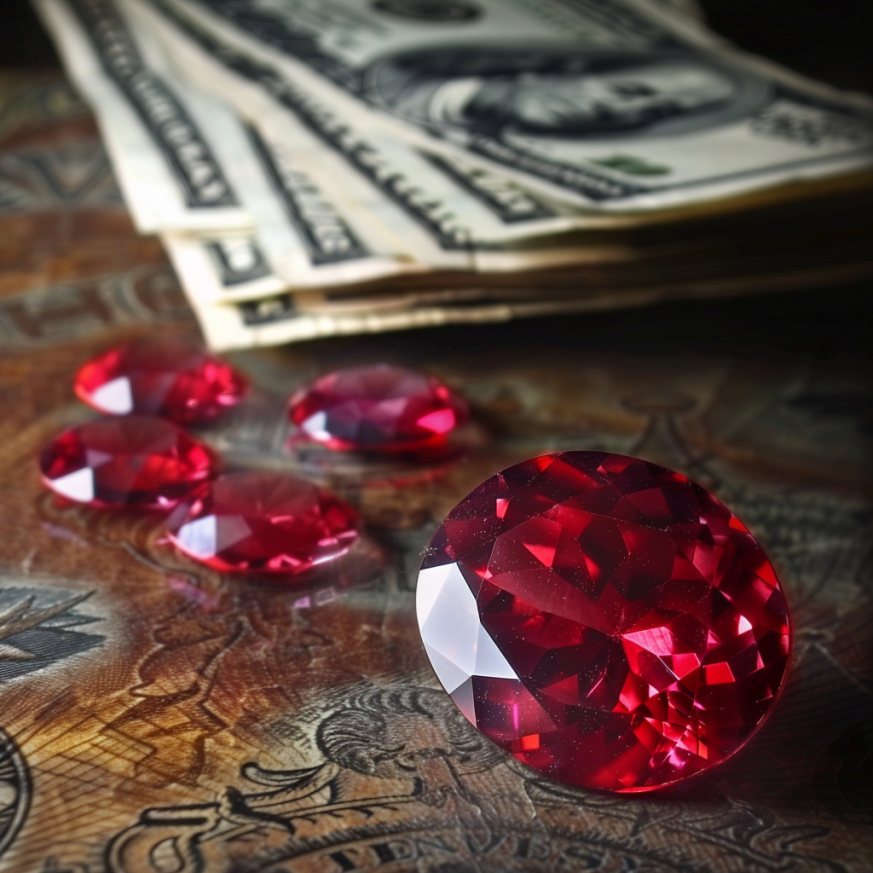Ruby Pricing Per Carat
Understanding Ruby pricing per carat in rubies is crucial for buyers and collectors, as the value of rubies increases exponentially with size and quality. Unlike diamonds, where price increases gradually, rubies, especially those of fine quality, see significant jumps in price as carat weight increases. Factors like color, clarity, origin, and treatment all impact the price per carat of a ruby.

1. How Carat Weight Affects Ruby Pricing
Ruby prices do not increase linearly with carat weight. Instead, larger rubies, particularly those over 1 carat with high-quality color and clarity, command premium prices due to their rarity.
| Carat Weight | Price Range Per Carat (Approx.) | Notes |
| 0.50 – 1.00 ct | $500 – $5,000 | Smaller rubies with good color and clarity are more affordable. |
| 1.00 – 2.00 ct | $2,000 – $10,000+ | Fine-quality rubies increase significantly in price. |
| 2.00 – 5.00 ct | $5,000 – $50,000+ | Larger rubies with top color and minimal treatment are rare. |
| 5.00+ ct | $20,000 – $100,000+ | High-quality, untreated rubies in this size are extremely valuable. |
2. Factors That Influence Ruby Pricing Per Carat
A. Color – The Most Important Factor
- “Pigeon Blood” Red: The most valuable and sought-after ruby color, found mainly in Burmese rubies, with prices reaching the highest tiers.
- Medium to Deep Red: Highly desirable, but slight variations in hue can lower value.
- Pinkish or Orangish Red: Typically less valuable, often considered fancy sapphires instead of rubies.
B. Clarity – Eye-Clean vs. Included Rubies
- Eye-Clean Rubies: Extremely rare and valuable.
- Moderately Included: Acceptable in rubies but can affect pricing.
- Heavily Included: Lower transparency reduces price per carat significantly.
R10260| play | medium| middle| “Eye Clean”
R14141| play | medium| middle| “Very Slightly Included”
R13306| play | medium| middle| “Slightly Included ”
C. Origin – Where the Ruby Comes From
- Burmese Rubies (Myanmar): The most valuable, especially those from Mogok, commanding the highest prices per carat.
- Mozambique Rubies: High-quality stones that are becoming more popular in the market.
- Thai & Cambodian Rubies: Often darker due to higher iron content, priced lower than Burmese rubies.
- Sri Lankan Rubies: Lighter pinkish-red rubies, valued less than deeper red stones.
R10108| play | medium| middle| “Burmese Ruby”
R10006| play | medium| middle| “Mozambique Ruby”
R10049| play | medium| middle| “Thai Ruby”
R12803| play | medium| middle| “Sri Lankan Ruby”
D. Treatments – Natural vs. Enhanced Rubies
- Untreated Rubies: Extremely rare and the most expensive per carat.
- Heat-Treated Rubies: More common and widely accepted, but priced lower than untreated gems.
- Fracture-Filled or Lead-Glass Rubies: The lowest value due to artificial enhancements that affect durability.
R10031| play | medium| middle| “No Enhancement”
R10032| play | medium| middle| “Heat Treated”
3. Market Trends and Investment Potential
- Demand for natural, untreated rubies is rising, making them an excellent investment.
- Larger rubies over 3 carats with rich color and minimal inclusions have seen record auction prices.
- Mozambique rubies are increasing in popularity as an alternative to Burmese stones.
Conclusion
The pricing per carat of rubies depends on a combination of color, clarity, origin, and treatment. High-quality rubies over 1 carat are rare, making their prices climb significantly. Buyers should focus on a balance of color and clarity while considering certified stones for authenticity and long-term value.
For more details, learn about Size vs. Carat Weight and understand how they impact a gemstone’s appearance and value.
